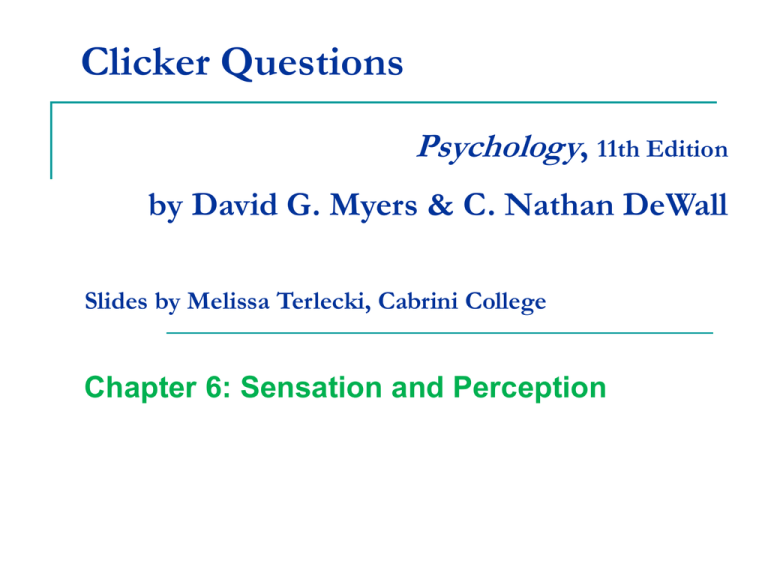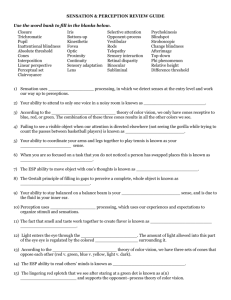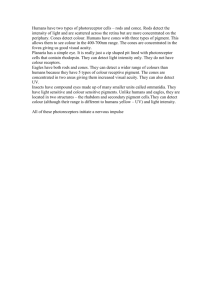Sensation and Perception Chapter 6 PowerPoint
advertisement

Clicker Questions Psychology, 11th Edition by David G. Myers & C. Nathan DeWall Slides by Melissa Terlecki, Cabrini College Chapter 6: Sensation and Perception 1. The minimum stimulus energy needed to detect a stimulus is called (the): A. B. C. D. Priming Subliminal Absolute threshold Difference threshold 1. The minimum stimulus energy needed to detect a stimulus is called (the): ANSWER A. B. C. D. Priming Subliminal Absolute threshold Difference threshold 2. Which portion of the eye is the transparent structure that changes shape to help focus images? A. B. C. D. Lens Retina Pupil Iris 2. Which portion of the eye is the transparent structure that changes shape to help focus images? ANSWER A. B. C. D. Lens Retina Pupil Iris 3. Which of the following is TRUE of cones? A. B. C. D. We have more cones than rods. Cones are located in the peripheral retina. Cones are best used in dim light. Cones detect color best. 3. Which of the following is TRUE of cones? ANSWER A. B. C. D. We have more cones than rods. Cones are located in the peripheral retina. Cones are best used in dim light. Cones detect color best. 4. According to the Young-Helmholtz trichromatic theory, which of the following is NOT one of the three colors our cones detect? A. B. C. D. Red Yellow Green Blue 4. According to the Young-Helmholtz trichromatic theory, which of the following is NOT one of the three colors our cones detect? ANSWER A. B. C. D. Red Yellow Green Blue 5. Which rule of perceptual organization shows that we fill in gaps to create whole objects? A. B. C. D. Proximity Continuity Figure-ground Closure 5. Which rule of perceptual organization shows that we fill in gaps to create whole objects? ANSWER A. B. C. D. Proximity Continuity Figure-ground Closure 6. Which structure of the ear is the coiled, fluid-filled tube? A. B. C. D. Eardrum Cochlea Oval window Auditory canal 6. Which structure of the ear is the coiled, fluid-filled tube? ANSWER A. B. C. D. Eardrum Cochlea Oval window Auditory canal 7. Which of the following exemplifies the volley principle? A. Place theory best explains how we sense low pitches. B. Frequency theory best explains how we sense high pitches. C. Place theory best explains how we sense high pitches. D. Frequency theory best explains how we sense intermediate pitches. 7. Which of the following exemplifies the volley principle? ANSWER A. Place theory best explains how we sense low pitches. B. Frequency theory best explains how we sense high pitches. C. Place theory best explains how we sense high pitches. D. Frequency theory best explains how we sense intermediate pitches. 8. Our sense of touch includes the perception of: A. B. C. D. pressure. temperature. pain. all of the above 8. Our sense of touch includes the perception of: ANSWER A. B. C. D. pressure. temperature. pain. all of the above 9. Which taste sensation indicates potential poisons? A. B. C. D. sweet sour bitter umami 9. Which taste sensation indicates potential poisons? ANSWER A. B. C. D. sweet sour bitter umami 10. Which of the following experiences does smell NOT commonly interact with? A. B. C. D. audition taste memory emotion 10. Which of the following experiences does smell NOT commonly interact with? ANSWER A. B. C. D. audition taste memory emotion Critical Thinking Questions 11. Two people look at the same piece of artwork. One person claims it’s brilliant while the other thinks it’s junk. What likely explains the difference in perception? A. B. C. D. Bottom-up processing Transduction Top-down processing Priming 11. Two people look at the same piece of artwork. One person claims it’s brilliant while the other thinks it’s junk. What likely explains the difference in perception? ANSWER A. B. C. D. Bottom-up processing Transduction Top-down processing Priming 12. Chloe’ is able to detect a one inch difference between a 12 inch and a 13 inch piece of paper, but not between a 1 mile, 1 inch and a 1 mile, 2 inch strip of road. What would explain this difference? A. B. C. D. Weber’s Law Difference threshold Absolute threshold Signal detection theory 12. Chloe’ is able to detect a one inch difference between a 12 inch and a 13 inch piece of paper, but not between a 1 mile, 1 inch and a 1 mile, 2 inch strip of road. What would explain this difference? ANSWER A. B. C. D. Weber’s Law Difference threshold Absolute threshold Signal detection theory 13. Niobi has had a long and exhausting day at work. Her usual 10 mile drive home seems much longer than it normally is because of: A. B. C. D. Sensory adaptation Priming Context effects Motivation and emotion 13. Niobi has had a long and exhausting day at work. Her usual 10 mile drive home seems much longer than it normally is because of: ANSWER A. B. C. D. Sensory adaptation Priming Context effects Motivation and emotion 14. Eduardo stares down a road and even though it appears that the sides of the road meet in the distance, he knows they remain evenly spaced. Which perspective of depth perception is he experiencing? A. B. C. D. Relative height Linear perspective Relative size Interposition 14. Eduardo stares down a road and even though it appears that the sides of the road meet in the distance, he knows they remain evenly spaced. Which perspective of depth perception is he experiencing? ANSWER A. B. C. D. Relative height Linear perspective Relative size Interposition 15. Penelope is an acrobat that often flips and turns in the air. Her ability to know where her head is in relation to the ground is due to her: A. B. C. D. vestibular sense. sensory interaction. limbic system. embodied cognition. 15. Penelope is an acrobat that often flips and turns in the air. Her ability to know where her head is in relation to the ground is due to her: ANSWER A. B. C. D. vestibular sense. sensory interaction. limbic system. embodied cognition.





